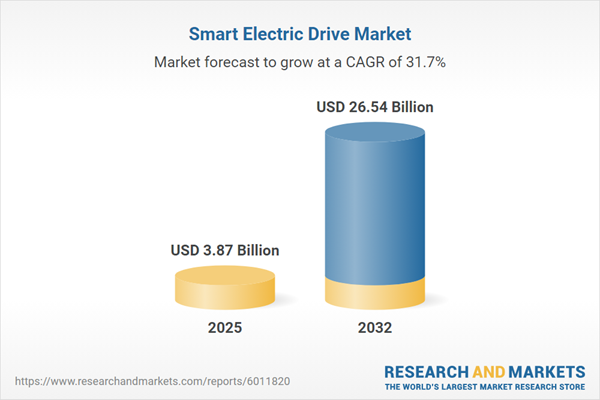Speak directly to the analyst to clarify any post sales queries you may have.
The smart electric drive market is gaining significant traction as organizations across sectors recognize electric propulsion’s pivotal role in redefining mobility, performance, and operational efficiency. Industry leaders are adopting advanced, sustainable technologies and digital solutions to meet evolving regulatory demands and changing user expectations.
Market Snapshot: Smart Electric Drive Market Growth & Outlook
The Smart Electric Drive Market grew from USD 2.93 billion in 2024 to USD 3.87 billion in 2025. It is expected to continue growing at a CAGR of 31.69%, reaching USD 26.54 billion by 2032. Sustained momentum in battery innovations, expanding digital integration, and rising commitment to sustainable mobility solutions are driving the sector’s rapid expansion.
Scope & Segmentation of the Global Market
This report provides a deep dive into the full spectrum of the smart electric drive market, examining its key technologies, major segments, and regional focus.
- Propulsion Type: All Electric vehicles, Plug-In Hybrid vehicles
- Vehicle Type: Light Commercial Vehicles; Passenger Cars—Hatchback, MPV, Sedan, SUV (Compact, Fullsize, Midsize)
- Battery Capacity Range: Less Than 30 kWh, 30 To 60 kWh, Greater Than 60 kWh
- End User: Private, Government, Commercial
- Sales Channel: Dealership, Direct, Online (Mobile App, Website)
- Geographic Coverage: Americas (United States, Canada, Mexico, Brazil, Argentina, Chile, Colombia, Peru), Europe, Middle East & Africa (United Kingdom, Germany, France, Russia, Italy, Spain, Netherlands, Sweden, Poland, Switzerland, United Arab Emirates, Saudi Arabia, Qatar, Turkey, Israel, South Africa, Nigeria, Egypt, Kenya), Asia-Pacific (China, India, Japan, Australia, South Korea, Indonesia, Thailand, Malaysia, Singapore, Taiwan)
- Key Companies: Tesla, Inc.; BYD Company Ltd.; SAIC Motor Corporation Limited; Volkswagen AG; Stellantis N.V.; General Motors Company; Hyundai Motor Company; BMW AG; Mercedes-Benz Group AG; Zhejiang Geely Holding Group Co., Ltd.
Key Takeaways for Senior Decision-Makers
- Sustained advancements in battery chemistry, intelligent software integration, and modular vehicle architecture continue to drive value for manufacturers and commercial operators seeking lower operational costs and improved scalability.
- Integrated digital connectivity—enabling predictive maintenance, over-the-air updates, and data-driven fleet management—creates new opportunities for service differentiation and customer engagement.
- OEMs and technology leaders are leveraging collaborations to accelerate the transition to electric platforms, improve vertical integration, and secure supply chain resilience amid changing policy and trade environments.
- Regional market dynamics show contrasting adoption cycles and regulatory frameworks, prompting local adaptation of products and business models to infrastructure readiness and consumer behavior.
- Growing convergence of shared mobility, vehicle autonomy, and integrated energy solutions reshapes the entire value chain, extending beyond product manufacturing to digital mobility ecosystems.
Tariff Impact and Domestic Production Dynamics
New U.S. tariff policies affecting electric drive imports and key components are increasing production costs for businesses reliant on global supply. In response, manufacturers intensify investment in domestic capacity, automation, and localized supply chains. This shift also prompts more agile manufacturing and a reevaluation of sourcing strategies—fostering ecosystem partnerships to reduce dependency on imports and bolster long-term competitiveness.
Proven Methodology & Data Sources
Market insights result from a blend of executive interviews, supply chain reviews, and firsthand user input. In-depth secondary research includes technical publications, regulatory documents, and corporate disclosures. All findings undergo expert validation and rigorous cross-checking, with strict data quality controls throughout the analytical process.
Why This Report Matters
- Enables executives to identify the most lucrative segments, technology partnerships, and growth regions for strategic investment.
- Equips decision-makers to navigate policy shifts, competitive threats, and evolving business models with data-backed confidence.
- Provides actionable intelligence for product development, supply chain optimization, infrastructure deployment, and cross-sector collaboration.
Conclusion
Senior stakeholders can use this report to inform strategic decisions, prioritize market entry points, and forge value-driven partnerships. Staying agile and leveraging integrated digital and mobility solutions will be key as the smart electric drive market continues its rapid evolution.
Additional Product Information:
- Purchase of this report includes 1 year online access with quarterly updates.
- This report can be updated on request. Please contact our Customer Experience team using the Ask a Question widget on our website.
Table of Contents
3. Executive Summary
4. Market Overview
7. Cumulative Impact of Artificial Intelligence 2025
Companies Mentioned
The companies profiled in this Smart Electric Drive market report include:- Tesla, Inc.
- BYD Company Ltd.
- SAIC Motor Corporation Limited
- Volkswagen AG
- Stellantis N.V.
- General Motors Company
- Hyundai Motor Company
- BMW AG
- Mercedes-Benz Group AG
- Zhejiang Geely Holding Group Co., Ltd.
Table Information
| Report Attribute | Details |
|---|---|
| No. of Pages | 181 |
| Published | October 2025 |
| Forecast Period | 2025 - 2032 |
| Estimated Market Value ( USD | $ 3.87 Billion |
| Forecasted Market Value ( USD | $ 26.54 Billion |
| Compound Annual Growth Rate | 31.6% |
| Regions Covered | Global |
| No. of Companies Mentioned | 11 |









